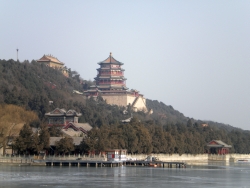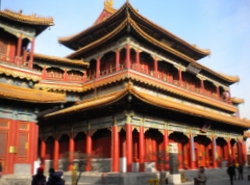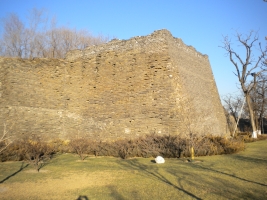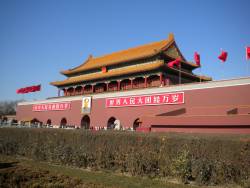Posts Tagged ‘Beijing’
Saturday, January 15th, 2011
In my final days of this trip I visited Beijing Ancient Observatory, the Summer Palace and Jingshan Park.
The Beijing Ancient Observatory was first established in 1442 in the Ming Dynasty, and is one of the oldest and longest operating astronomical observatories in the world. I explored the observatory grounds and buildings where there good interpretive displays on ancient astronomy, the history of the observatory, and the functions and operation of ancient astronomical equipment. I then climbed the ancient stairs to the observatory platform, located on top of a tower that was part of the old city wall, where there are several fascinating well-preserved pieces of historic astronomical equipment.
A journey on subway lines 2 and 4 took me from Dongzhimen station, near where I was staying, to Beigongmen station in Beijing’s north-west suburbs. Beigongmen station is right next to the North Palace Gate of the World Heritage-listed Summer Palace. Entering the gate I followed the steep meandering paths past ancient trees and historic pavilions to the crest of Longevity Hill where a spectacular view over the frozen Kunming Lake opened up.
The Summer Palace was built by Emperor Qianlong in 1750 to celebrate his mother’s birthday. Kunming Lake has a causeway imitating West Lake in Hangzhou. I walked out on the causeway for the stunning view back across the lake to the Tower of the  Fragrance of the Buddha which dominates Longevity Hill. I then walked back and strolled along the Long Corridor, an open-sided walkway with ornate roof and ceiling that spans the edge of the lake at the foot of Longevity Hill. On the ornate ceiling of the walkway there are an incredible 14,000 paintings. Fragrance of the Buddha which dominates Longevity Hill. I then walked back and strolled along the Long Corridor, an open-sided walkway with ornate roof and ceiling that spans the edge of the lake at the foot of Longevity Hill. On the ornate ceiling of the walkway there are an incredible 14,000 paintings.
I left the Long Corridor and ascended the steep stairs to the beautifully decorated Tower of the Fragrance of the Buddha which is a large three-storied octagonal structure with four sets of eaves. There were stunning views over the Summer Palace. After this I descended to the lake edge again to explore the halls and gardens in the eastern part of the Summer Palace, and then walked back to the North Palace Gate for my return journey. The Summer Place has, like the Imperial Palace, been a highlight of this trip.
Jingshan Park is located in central Beijing and covers an area of 230,000 square metres. The dominant feature of the park is a hill with the Wanchun Pavilion on its peak. After a short steep climb I enjoyed magnificent views over Beijing in all directions, including of the directly adjacent Imperial Palace. Built in the Liao and Jin Dynasties, Jingshan has a history of almost one thousand years. The artificial hill was constructed in the 15th century from earth excavated to create the moats for the Imperial Palace.
On a future trip I will explore the attractions outside the Beijing city area including the Great Wall and Ming Tombs.
Tags: Beigongmen, Beijing, Dongzhimen, Emperor Qianlong, Jin Dynasty, Kunming Lake, Liao Dynasty, Long Corridor, Ming Dynasty, Qing Dynasty, Tower of the Fragrance of the Buddha, Wanchun Pavilion Posted in China Travel, My China Trips | Comments Off on Beijing Ancient Observatory, Summer Palace and Jingshan Park
Tuesday, January 11th, 2011
After exploring the fascinating treasures of the Henan Museum and enjoying the hospitality of Zhengzhou’s very friendly people I returned to Beijing by train on 9 January. Since then I have visited two more of Beijing’s significant attractions – Yonghegong Lama Temple and the Temple of Heaven.
 Yonghegong Lama Temple, the largest lamasery in Beijing, was built in 1694 as the residence of Prince Yong of the Qing Dynasty. After the prince came to the throne as Emperor Yongzheng he in 1725 changed his old residence into a temporary dwelling palace called “Yonghegong” meaning palace of harmony and peace. In 1744 his successor Emperor Qianlong changed the palace into a lama temple. In the temple halls there are many Buddhist statues, paintings and relics including a breathtaking 18-metre high Buddha carved from one piece of white sandalwood. Yonghegong Lama Temple, the largest lamasery in Beijing, was built in 1694 as the residence of Prince Yong of the Qing Dynasty. After the prince came to the throne as Emperor Yongzheng he in 1725 changed his old residence into a temporary dwelling palace called “Yonghegong” meaning palace of harmony and peace. In 1744 his successor Emperor Qianlong changed the palace into a lama temple. In the temple halls there are many Buddhist statues, paintings and relics including a breathtaking 18-metre high Buddha carved from one piece of white sandalwood.
The Temple of Heaven, built from 1420, was where emperors of the Ming and Qing Dynasties went to worship heaven and offer sacrifices to pray for bumper harvests and favourable rain. A spectacular group of ancient temple buildings sits in 273 hectares of beautiful parkland, including the landmark Hall of Prayer for Good Harvests and Circular Mound Altar.
For this part of the trip I’m staying in Dongzhimen, which is located near to the Beijing Worker’s Stadium and Gymnasium and Beijing’s embassy district. Like Chongwenmen where we stayed earlier in the trip, Dongzhimen was previously the location of an ancient city gate. It also has a subway station that accesses two subway lines as well as the Airport Express train service.
Tags: Beijing, Buddha, Buddhism, Buddhist, Circular Mound Altar, Emperor Qianlong, Emperor Yongzheng, Hall of Prayer for Good Harvests, Henan Museum, Ming Dynasty, Prince Yong, Qing Dynasty, Temple of Heaven, Yonghegong, Yonghegong Lama Temple, Zhengzhou Posted in China Travel, My China Trips | Comments Off on Yonghegong Lama Temple and the Temple of Heaven
Tuesday, January 4th, 2011
 On 2 January we took a day trip to the city of Tianjin, famous for its great food and European colonial architecture. The 130km journey from Beijing to Tianjin took only 30 minutes on the new high speed rail service which reached a speed of 325 km/h. China has 17,000 km of high speed rail lines under construction across the country, and metro rail networks are being built in many cities. On 2 January we took a day trip to the city of Tianjin, famous for its great food and European colonial architecture. The 130km journey from Beijing to Tianjin took only 30 minutes on the new high speed rail service which reached a speed of 325 km/h. China has 17,000 km of high speed rail lines under construction across the country, and metro rail networks are being built in many cities.
Beijing’s beautiful Beihai Park was our destination on 3 January. Located in the centre of Beijing, Beihai Park is one of the oldest, largest and best preserved ancient imperial gardens in China with a history of about 1,000 years.
A major landmark in Beihai Park is the majestic White Dagoba which is situated on the peak of Qionghua Islet.
Sunday, January 2nd, 2011
 In Beijing we are staying at Chongwenmen, which means “Chongwen gate”. In Beijing we are staying at Chongwenmen, which means “Chongwen gate”.
Chongwen gate was one of the gates in Beijing’s ancient city wall, and construction of the gate commenced in 1436 in the Ming Dynasty. Chongwen gate no longer stands, however leading east from Chongwenmen a 1.5 km section of the ancient city wall has been protected in the Ming City Wall Site Park.
About 1.5 km west of Chongwenmen another of the gates, Zhenyangmen (Zhenyang gate) still stands at the southern end of Tian’anmen Square. Zhenyangmen is commonly known as Qianmen (front door) and is the highest and most magnificent city gate in Beijing.
Chongwenmen now features major department stores and numerous restaurants as well as a subway station accessing two lines of Beijing’s extensive, efficient and expanding subway network.
Saturday, January 1st, 2011
 Tian’anmen Square and the Imperial Palace (also known as the Forbidden City) were the first of Beijing’s numerous significant attractions that I visited after arriving in China’s capital on 27 December. Tian’anmen Square and the Imperial Palace (also known as the Forbidden City) were the first of Beijing’s numerous significant attractions that I visited after arriving in China’s capital on 27 December.
Tian’anmen Square takes its name from the Tian’anmen gate (Gate of Heavenly Peace) to the Imperial Palace at the north of the square. Under clear blue skies I joined the many people who were in the square visiting the Monument to the People’s Heroes and the Mausoleum of Mao Zedong, and then commenced an exploration of the Imperial Palace. I had seen photographs of the Imperial Palace (Forbidden City), but pictures can’t convey the extraordinary scale and grandeur of this vast complex.
We have since visited Beijing’s ancient Drum and Bell Towers and Prince Gong Mansion, toured historic Hutongs, and of course enjoyed Beijing’s outstanding food.
Tags: Beijing, Bell Tower, Drum Tower, Forbidden City, Hutong, Hutongs, Imperial Palace, Prince Gong Mansion, Tian'anmen, Tian'anmen Square Posted in China Travel, My China Trips | Comments Off on Exploring Beijing’s treasures
|
|
 Fragrance of the Buddha which dominates Longevity Hill. I then walked back and strolled along the Long Corridor, an open-sided walkway with ornate roof and ceiling that spans the edge of the lake at the foot of Longevity Hill. On the ornate ceiling of the walkway there are an incredible 14,000 paintings.
Fragrance of the Buddha which dominates Longevity Hill. I then walked back and strolled along the Long Corridor, an open-sided walkway with ornate roof and ceiling that spans the edge of the lake at the foot of Longevity Hill. On the ornate ceiling of the walkway there are an incredible 14,000 paintings. Yonghegong Lama Temple, the largest lamasery in Beijing, was built in 1694 as the residence of Prince Yong of the Qing Dynasty. After the prince came to the throne as Emperor Yongzheng he in 1725 changed his old residence into a temporary dwelling palace called “Yonghegong” meaning palace of harmony and peace. In 1744 his successor Emperor Qianlong changed the palace into a lama temple. In the temple halls there are many Buddhist statues, paintings and relics including a breathtaking 18-metre high Buddha carved from one piece of white sandalwood.
Yonghegong Lama Temple, the largest lamasery in Beijing, was built in 1694 as the residence of Prince Yong of the Qing Dynasty. After the prince came to the throne as Emperor Yongzheng he in 1725 changed his old residence into a temporary dwelling palace called “Yonghegong” meaning palace of harmony and peace. In 1744 his successor Emperor Qianlong changed the palace into a lama temple. In the temple halls there are many Buddhist statues, paintings and relics including a breathtaking 18-metre high Buddha carved from one piece of white sandalwood. On 2 January we took a day trip to the city of Tianjin, famous for its great food and European colonial architecture. The 130km journey from Beijing to Tianjin took only 30 minutes on the new high speed rail service which reached a speed of 325 km/h. China has 17,000 km of high speed rail lines under construction across the country, and metro rail networks are being built in many cities.
On 2 January we took a day trip to the city of Tianjin, famous for its great food and European colonial architecture. The 130km journey from Beijing to Tianjin took only 30 minutes on the new high speed rail service which reached a speed of 325 km/h. China has 17,000 km of high speed rail lines under construction across the country, and metro rail networks are being built in many cities. In Beijing we are staying at Chongwenmen, which means “Chongwen gate”.
In Beijing we are staying at Chongwenmen, which means “Chongwen gate”. Tian’anmen Square and the Imperial Palace (also known as the Forbidden City) were the first of Beijing’s numerous significant attractions that I visited after arriving in China’s capital on 27 December.
Tian’anmen Square and the Imperial Palace (also known as the Forbidden City) were the first of Beijing’s numerous significant attractions that I visited after arriving in China’s capital on 27 December.